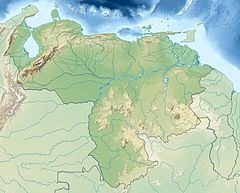Anomaloglossus tamacuarensis
| Anomaloglossus tamacuarensis | |
|---|---|
| Scientific classification | |
| Domain: | Eukaryota |
| Kingdom: | Animalia |
| Phylum: | Chordata |
| Class: | Amphibia |
| Order: | Anura |
| Family: | Aromobatidae |
| Genus: | Anomaloglossus |
| Species: | A. tamacuarensis
|
| Binomial name | |
| Anomaloglossus tamacuarensis | |
| Synonyms[3] | |
|
Colostethus tamacuarensis Myers and Donnelly, 1997[2] | |
Anomaloglossus tamacuarensis is a species of
Amazonas state of Venezuela as well as in the adjacent Amazonas state of Brazil (where the range is known as Serra do Tapirapecó).[3][4]
Records of Anomaloglossus tamacuarensis near the border between Venezuela and Brazil.
Etymology
The
type locality, Pico Tamacuari in the Sierra Tapirapecó.[2]
Description
The
dorsum is brown to yellowish brown with darker brown markings; dorsal skin is granular. There is a poorly defined, pale oblique lateral line. Males have gray throat, white-stippled chin, and pale dirty green or yellowish venter, where females have pale gray or silvery white throats and silvery white venters.[2]
Anomaloglossus tamacuarensis resembles Duida-Marahuaca Massif.[2]
Habitat and conservation
Anomaloglossus tamacuarensis is found in or near rocky forest streams. The Venezuelan
above sea level, whereas the Brazilian record is from 350 m (1,150 ft) asl.[1][4] It is active both day and night.[4] Males call from beneath large boulders. Not much information is known about this species but flash flooding is thought to threaten it as the flooding occurs in its habitat. The species is protected by the Parima Tapirapecó National Park in Venezuela.[1]
References
- ^ . Retrieved 16 November 2021.
- ^ hdl:2246/3610.
- ^ a b Frost, Darrel R. (2017). "Anomaloglossus tamacuarensis (Myers and Donnelly, 1997)". Amphibian Species of the World: an Online Reference. Version 6.0. American Museum of Natural History. Retrieved 3 May 2017.
- ^ a b c Caramaschi, U.; de Niemeyer, H. (2005). "Geographic distribution: Colostethus tamacuarensis" (PDF). Herpetological Review. 36: 73.


